
One of the things I wanted to do this summer was climb the south face of Shoshone Spire in Blodgett Canyon, but this year didn't seem to be the right one to do it. The forest fires started in early, and then in September Dona and I headed to Australia and Papua, Indonesia.
When we returned I immediately came down with a blechy flu-like virus. I tried to ignore it and went climbing the second day after we got back but that didn't seem to have the desired effect; it pretty much put me out of commission. The weather turned wet and rainy, and I missed what I thought were the last few days for any good climbing before winter set in.
However, one brief window of two sunny days magically appeared in the forecast, albeit with a little wind. I sent a note to my friend Claudine; she was hesitant because of the wind but game.
The forecast the night before had been for sunny with wind coming up about 15:00; we hoped to be topped out by then. But by morning as I was driving down to Missoula the forecast had moved the wind up to noon. I picked Claudine up and we drove to the trailhead. On this gorgeous mid-week fall day it was deserted.
Shoshone is the smaller of numerous spires and cliffs on the north side of Blodgett Creek. Its south face is a gorgeous triangle of fractured rock; there are cracks running everywhere. There is a broad band at the bottom known as Lunch Ledge; below that is about 50 meters of broken cliffs. You can exit off at Lunch Ledge, so we agreed to re-evaluate the situation when we got there and quit if it was too windy. Claudine had unpleasant memories of being higher up in bad wind and it wasn't fun...
The descent is a careful walk-off down to Lunch Ledge, then a two-rope rappel from there to the base. We had two ropes with us; our plan was to leave the second rope on Lunch Ledge since we didn't need it above there.
Claudine is in better shape than I am and started off at about 08:30 at a good clip. We enjoyed the warm sunlight when it arrived. We stopped to admire Drip Buttress and the Prow. I climbed Drip Buttress in the Spring with my friend Kurt, and Claudine has done it several times as well.
 |
| Drip Buttress and the Prow |
Shoshone Spire is by far the smallest thing around in the group of spires in which it nestles. At first glance you often don't even notice it. But when you examine it individually it is an impressive hunk of rock, and aesthetically outstanding as far as climbing goes.
 |
| Flathead Buttress, Shoshone, Nez Perce, Blackfoot Dome |
 |
| Flathead Buttress, Shoshone, Nez Perce |
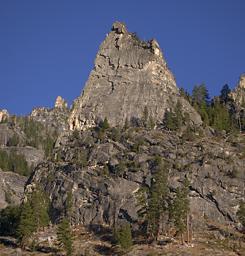 |
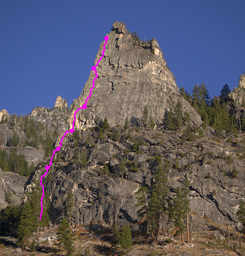 |
| Shoshone | Our Approximate Route |
We arrived at the base of the climb about 10:00. Shortly after we arrived we heard voices and two other climbers showed up. They were heading on to Flathead Buttress, the next big hunk of rock to the west. They were going to be doing a longer and harder route than we were. We wished them well and hoped the predicted wind wouldn't give them too much trouble.
There are several ways to climb up to Lunch Ledge. Since it was still a bit chilly we opted to make our way up some broken rock in the sun. Claudine led off about 10:15, trailing our second rope behind. It's nominally two pitches up to the ledge, but we broke it into three to keep rope drag down. The plan was for me to lead the last pitch up to the ledge, but when we got there it was easier to let her do it rather than swap gear.
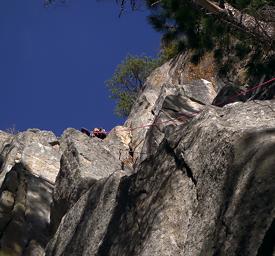 |
| Claudine on the First Pitch |
We arrived at Lunch Ledge about 11:30. Looking down the valley it was still a gorgeous clear day; looking up to the west we could see some high wispy clouds moving in, hints of the wind predicted.
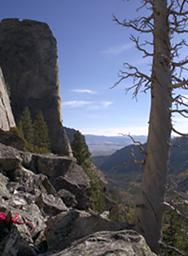 |
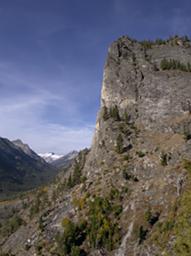 |
| Looking Down Valley
from Lunch Ledge |
Looking Up Valley
Flathead Buttress on Right |
The rappel to the base from Lunch Ledge used to be off a large Ponderosa Pine tree. It's easy to identify from the base of the climb, but you can't even see the tree from Lunch Ledge. You have to scramble (carefully) down quite a ways before you get to it. A friend had had to do that once in the dark when he didn't know exactly where it was, and it was a bit of an adventure. Claudine showed me her markers for where the descent begins, a hint that had been passed down by one of her climbing buddies. It's a pair of large Ponderosa Pines whose trunks form a "Vee"; there's a large block on the rock behind them.
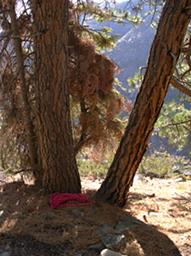 |
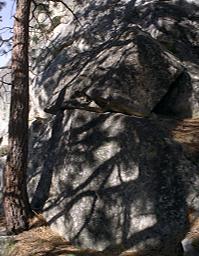 |
| Vee Trees
Rap Tree / Anchors are Downslope |
Block Above Vee Trees |
We stashed the second rope by the vee trees, ate a snack, and sorted gear. The wind had started to kick up a bit, but it wasn't too bad and we decided to continue on. I started up pitch three, the first of the climbing on the face above Lunch Ledge. There is more than one way to climb this route; I started up a book which had a fixed nut and a fixed pin on it. I headed for a break in the rock where there are several small pines growing. The climbing was really fun and well-protected.
Looking up at the face, we both thought we would be using lots of medium-sized cams for protection. But many of the wider cracks are flared, and we ended up using a lot of small stuff as well. I was delighted to have my small Metolius cams along.
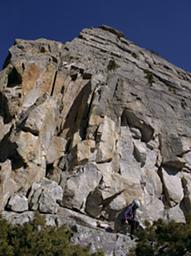 |
| Looking Up from Lunch Ledge |
I set up an anchor by the tree and brought Claudine up.
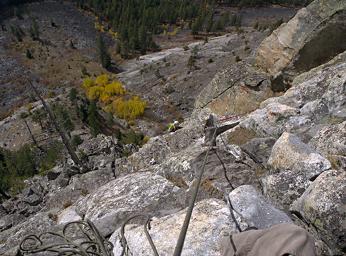 |
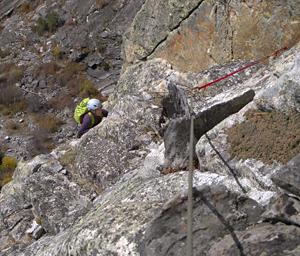 |
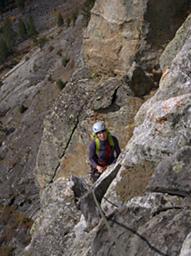 |
| Claudine Following Pitch Three | ||
The weather was still sunny but the wind was increasing; Claudine decided to pull her "puffy" down sweater out of the pack and tie it on where it would be handy once she got to her belay. Then she started up the fourth pitch, heading for a large notch in the ridge.
 |
| Looking Down Valley, Nez Perce on Left |
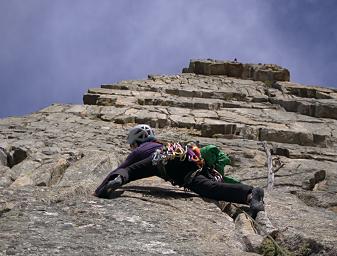 |
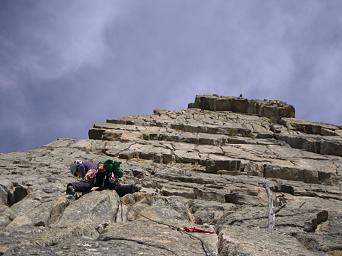 |
| Claudine Leading Pitch Four | |
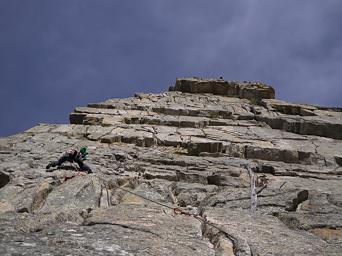 |
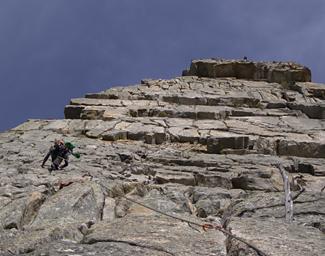 |
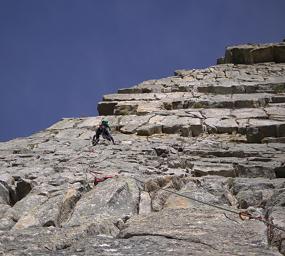 |
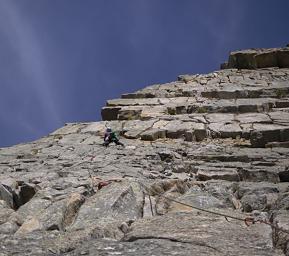 |
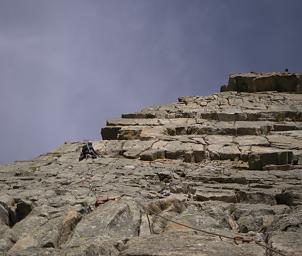 |
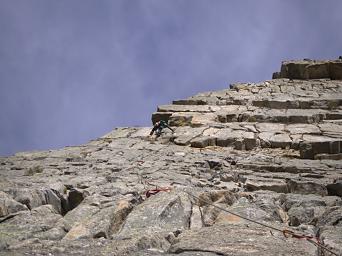 |
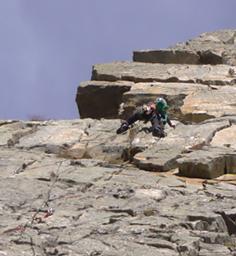 |
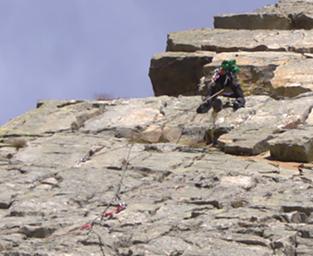 |
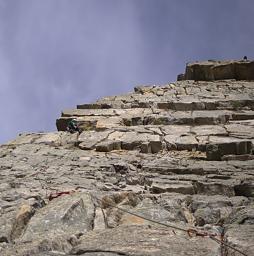 |
When I arrived at the anchor, Claudine had her puffy jacket on. The clouds were spilling over in the west and the wind was blasting away in fits and starts. When it was calm, it was really pleasant; when it wasn't, you were glad for all the clothes you had on.
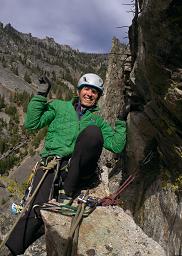 |
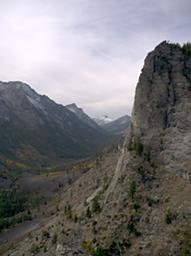 |
| Claudine at the
Pitch Four Anchor |
Looking Up Valley,
Flathead Buttress on Right |
From Claudine's belay in the notch, pitch five starts off with a small roof you have to work your way around and over. I eyed it rather carefully; overhangs intimidate me on general principles, and this one is half way up the face. I suppose it's a lot safer falling from there than falling where you can hit the ground, but psychologically it's not the same. It's a photogenic move if you have your belay set up so you can lean out and belay and take pictures at the same time. Unfortunately Claudine didn't have her point-and-shoot with her, and with the wind we were more focused on climbing and getting off before it got really bad than taking pictures.
Anyway, it was my lead, and I was grateful for the nice crack right at the lip; a #3 Camalot fit just right. Getting out and over the lip wasn't too complicated, but the next few moves bothered me. My feet were solid but not something I could just ignore, and the wind started gusting pretty hard. I really wanted another piece of protection, but the cracks I was staring at were shallow and flared. I held on and waited for a lull while the wind pushed me around. Stretching out and peering a bit farther right I found something I could sink a small cam into. I'm not sure why that extra protection made me feel so much better; if I had fallen I would have ended up low enough I still would have had to surmount the overhang again. The mind is a strange animal; mine needs better training. I clipped off the cam and continued on up, heading for the next large notch in the ridge, a bit below the big overhang at the top.
The wind wasn't too bad for the rest of the pitch; the face was just enough in the lee if one wasn't right over by the corner. I set up a belay at the notch and brought Claudine up.
Under non-windy conditions it shouldn't be too difficult to communicate between climbers on these upper pitches, but the wind made it impossible. We agreed that when the rope started moving up steadily without pause that was an indication the lead climber was off belay. When the remaining rope started steadily going up the belayer was clearly bringing up the slack and getting ready to belay. When it came taut the belayer should wait "a while"; when there were periodic gentle tugs it was an indication you were on belay and could clean up and start climbing.
Claudine appeared out of the notch in short order, and had a great time climbing up to where I was.
 |
 |
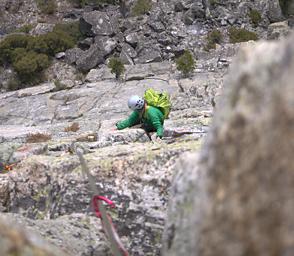 |
| Claudine after Exiting her Belay Notch | Following Pitch Five | |
 |
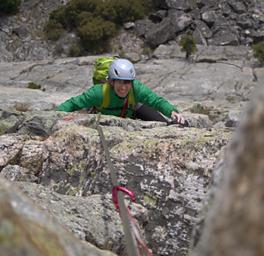 |
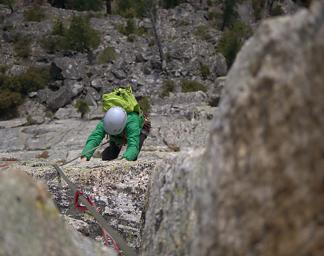 |
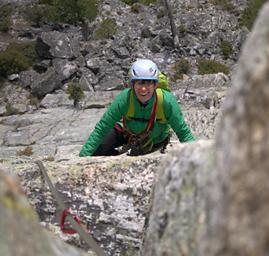 |
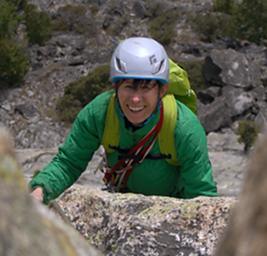 |
With the wind gusting steadily, Claudine exited my belay notch on the left (North), continuing to the summit on low fifth class rock. We still placed some protection; a mistake here would have not been any better than anywhere else on the climb.
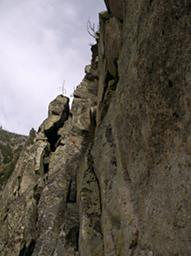 |
| Pitch Six |
There are several alternate finishes to the "standard" South Face route. One can continue on to the right of the notch where I belayed, going up to the summit and left of the overhang. One can also traverse right under the overhang and then go up and over it. I would like to try that variation next time, when the wind is not blowing.
When we summited the sun was still shining periodically, but the wind was blowing steadily and gusting more. It was about 14:15; we had made good time. We ate a snack and lightened our water bottles then packed up and started the scramble down to Lunch Ledge.
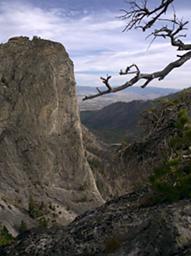 |
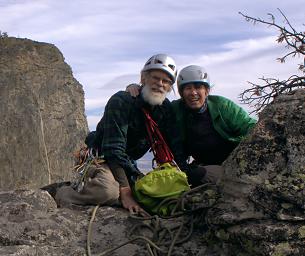 |
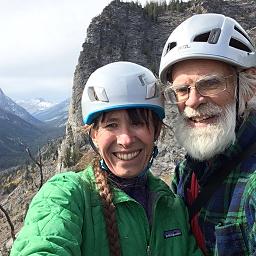 |
| Looking Down Valley from Summit
Nez Perce on Left |
|
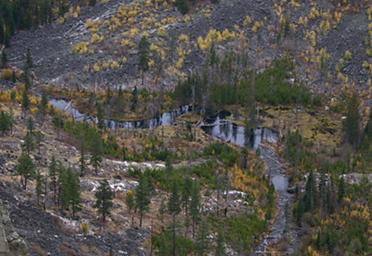 |
| Beaver Ponds |
I was surprised at how far below the vee trees the rap station was. The tree marking the spot is a medium Ponderosa Pine with branches arranged like a cross. It's easy to identify from below, but you can't even see it from Lunch Ledge. If one did not know the drill, it would be easy to bumble around for quite a while. You down climb a good 30m or so from the vee trees before you can even see the rap tree. There is a rap anchor on the rock behind the tree.
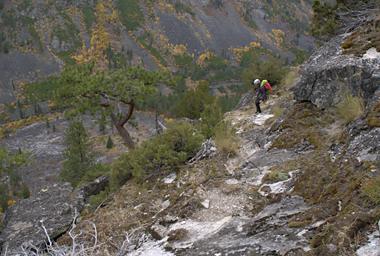 |
 |
| Rap Tree | Claudine Rappelling |
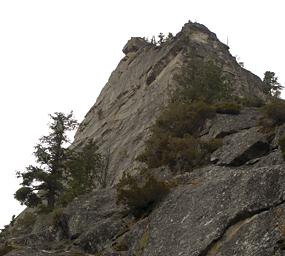 |
| Upper Face from East End of Lunch Ledge |
We were back at our packs about 15:30, headed down about 16:10, and back at the car at 17:00.
I dropped Claudine off and headed on home. I got home in the dark, where I found a big Ponderosa Pine had blown down across our road. It had clipped the pedestal where the telephone connects and where I have (er... had) a rain gauge and a platform for measuring snowfall.
 |
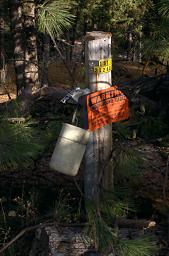 |
| I guess there was some wind... | Phone Pedestal |
A great climb, and a great finish to the climbing season.